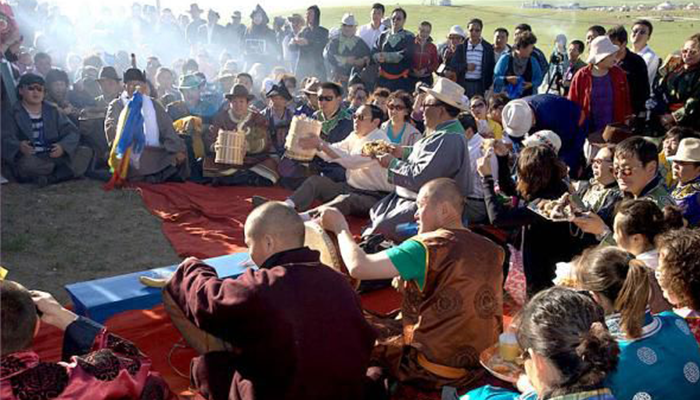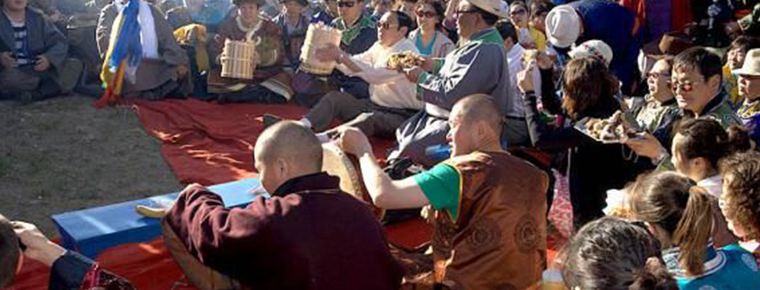Sebin Festival of Ewenki Nationality
Sebin Festival of Ewenki Nationality
"Serbin" is an Ewenki language, meaning "happy and peaceful". Sebin Festival is a traditional festival of the Ewenki people. On Sebin Festival, Ewenki hunters gather together. Celebrations will be held. All tribes, men, women, old and young, will be attended by Song, presided over by tribal chiefs. Simple hunters lit bonfires, sang and danced around them, offered sacrifices to the God Bayiannai, and held grand banquets. After the banquet, the hunters continued to dance until dawn the next day.
On May 23, 2011, the "Ewenki Sebin Festival" declared by Nehe City, Heilongjiang Province, was listed in the third batch of national intangible cultural heritage list with the approval of the State Council.
historical origin
Ewenki is one of the less populous ethnic groups in China. They live in the junction of Great Hinggan Mountains and Hulunbeir Grassland. They have their own language and no written language. Sebin Festival is an Ewenki language, meaning "happy and peaceful". It is reported that the current traditional Sebin Festival folk activities include worship of mountain gods, ethnic singing and dancing performances, traditional competitions, games, picnic wine banquets, bonfire parties, etc. Its customs are primitive and primitive, unique.
According to historical records, the ancestors of the Ewenki people, who lived by hunting, celebrated three days by singing and dancing every time they hunted such beasts as bears, which was the rudiment of the original Sabine Festival. But bears are not easy to catch, so the early Sebine Festival did not have a fixed time, and the content was relatively single because of the "bear sacrifice". Later, owing to the sharp decrease in the number of bears, the Ewenks began to hunt minks, deer and other animals. The Sebin Festival also gradually transited from bear sacrifice to mountain god sacrifice. Sabine Festival's sacrifices and carnivals are also constantly enriched, gradually increasing such content as imitating animal and bird singing and dancing performances, hunting, gathering and production of labor competitive games, as well as Bonfire Dance derived from heating carnival. With the development of the times, the religious color of today's Sebin Festival is gradually fading away, and gradually evolved into the annual grand carnival of the tribe.
Festival activities
Sebin Festival begins with sacrifice. Sacrifices are usually presided over by family, tribal leaders or tribal shamans, offering deer, cattle, sheep, horse milk and other sacrifices in front of mountain god tablets or Obo, in order to pray for good weather, prosperity of human beings and animals, and peace in all seasons. Following the sacrificial ceremony, songs and dances reflecting the Ewenki ethnic style and features and competitive activities have been launched one after another. During this period, a series of traditional performances, such as Luzhijile, Zandale and horse racing, archery, wrestling, were staged one by one. It was not until the beginning of the "picnic" that the traditional dance ended. On the "picnic of customs", the younger generation presents mare's milk to the elders, while the elder distributes auspicious gifts to the children. The picnic wine banquet will continue until the bonfire party, which is the last part of Sebin Festival and the climax of the festival. Men, women and children in the family or tribe are enjoying themselves by drinking, dancing around the campfire (also known as circle dance) and carnivalizing until dawn the next day.
Inheritance value
Ewenki is an ancient nation. They are Ewenki hunters living in big forests. Ewenki Autonomous Banner is located in the junction of Great Hinggan Mountains and Hulunbeir Grassland. Historically, Ewenki people who live in forests and hunt for a living have extremely harsh living conditions, but life can not always be in sorrow and pain. Therefore, they strive to create a happy, peaceful and happy living environment. They encourage each other in the national assembly, and they surround them. The bonfire sang and danced, and there was a carnival like Sebin's Day. In ancient times, Ewenki hunters gathered to celebrate the Sebin Festival. All the tribes, men, women, old and young, attended and were presided over by tribal chiefs. Simple hunters lit bonfires, sang and danced around them, offered sacrifices to the God Bayiannai, and held grand banquets. After the banquet, the hunters continued to dance until dawn the next day.
In the sixteenth century, "Shamanism" emerged among the Ewenki people, believing that "Shaman" was a "god" who could expel the evil ghosts of patients. Shamanism has spread to every clan, each clan has its own "Shaman". Since then, the Ewenki people began to believe in Shamanism, and the "Sebin Festival" characterized by totem has been lost for a time. However, since 1994, some folk festivals have been restored in the Ewenki Autonomous Banner of Inner Mongolia Autonomous Region. Sebin Festival is held on June 18 every year. Rainbow song is a Festival song of Ewenki Sebin Festival.
Inheritance and protection
In the 16th century, "Shamanism" emerged among the Ewenki people, believing that "Shaman" was a "god" who could expel the evil ghosts of patients. Shamanism has spread to all "Uriliang" (clan), each clan has its own "Shaman". Since then, the Ewenki people began to believe in Shamanism, and the "Sebin Festival" characterized by totem disappeared.
After the founding of the People's Republic of China, the people's government of Inner Mongolia Autonomous Region approved the restoration of the Ewenki ethnic name on March 5, 1958, abolished the nicknames "Solon", "Tungus", "Yakut" and so on, and the Ewenki ethnic group realized the unification of the ethnic name. The Ewenki Autonomous Banner was established on August 1, 1958 with the approval of the State Council. At the same time, the Ewenki people scattered in other places have established nine ethnic townships. In December 1984, the Ewenki Research Society of Inner Mongolia Autonomous Region was established. According to the requirements and wishes of the Ewenki people, the Ewenki Research Society of the Autonomous Region has consulted extensively on the name and time of Ewenki festivals, and the Ewenki Research Society of Heilongjiang Province has also participated in the discussion. At the third member congress of the Ewenki Research Association in the autonomous region, the name of "Sebin" was unanimously adopted as the Ewenki festival, and the festival time was set at June 18 each year. The Rainbow Song was tentatively designated as the Ewenki Festival song. The banner, the cadres and the masses of Ewenki nationality townships (Sumu, Ethnic Village and Gacha) were called upon to carry out festival activities at that time.


-
1.Ming Ming Dynasty Tombs Scenic Area
Ming Tombs, World Cultural Heritage, National Key Cultural Relics Protection Units, National Key Scenic Spots, National AAAAA Tourist Scenic Spots.
Time 2018-11-24 -
2.China of chunqiu yancheng tourist area
China Spring and Autumn Yancheng Tourist Area (also known as Yancheng, Spring and Autumn Yancheng) is located in the central city of Wujin District, Changzhou City
Time 2018-12-06 -
3.Shanghai Wildlife Park
Shanghai Wildlife Park, located at 178 Nanliu Highway, Pudong New Area, Shanghai, is the first National Wildlife Park in China built by the Shanghai Municipal People's Government and the State Forestr
Time 2018-12-19 -
4.Chaohu Lake Scenic Area
Located in the middle of Anhui Province, Chaohu Lake is located in Hefei, Lianhuai Tongjiang River, 55 kilometers east-west, 22 kilometers South-North wide. Its perennial water area is about 760 squar
Time 2019-01-05 -
5.The Ming Toms
The Obvious Tomb is located on Chunde Mountain, 5 kilometers northeast of Zhongxiang City, Hubei Province. It was built in 1519 in Zhengde, Ming Dynasty. It was built in 1566 in Jiajing
Time 2019-02-07 -
6.Eight claw Fish Powder Pueraria Decoction
500 grams of Pueraria Thunb, 50 grams of octopus, 400 grams of pork legs, four candied dates, and 1/6 peel.
Time 2019-03-27 -
7.Han tune
The mast of Hanzhong Diaoqu, a local traditional drama in Hanzhong City, Shaanxi Province, is one of the national intangible cultural heritages.
Time 2019-05-02 -
8.Silver and Copper Ware Making and Gold smelting Techniques
Silver and bronze wares production and gold mincing skills, local traditional skills in Huangzhong County, Qinghai Province, one of the national intangible cultural heritage.
Time 2019-07-13 -
9.Processing Technology of Traditional Chinese Medicine
Processing technology of traditional Chinese medicine, one of the means of preparation or extraction of traditional Chinese medicine, is declared by the Chinese Academy of Traditional Chinese Medicine
Time 2019-08-03 -
10.The Bronze Drum Custom of the Zhuang Nationality
Bronze drum is a percussion instrument created by Pu and Yue people in ancient China. Up to now, it has a history of more than 2700 years. Guangxi has the largest number and the widest distribution. T
Time 2019-08-16 -
11.The world is so big still meet you Cheng Xiang Tik Tok Songs 2020 Hot Songs
"The world is so big still meet you " is composed by htet Aung Lwin and sung by Cheng Xiang. It is the Chinese version of myanmar music "for Ma". It was officially released on Janu
Time 2020-05-21 -
12.Luzhou Medical and health
By the end of 2018, there were 46 primary health institutions and 39 other health institutions in the city, including 46 primary health institutions and 1 professional health institution. Among the hospitals, there are 97 general hospitals, 15 TCM hospitals and 35 specialized hospitals
Time 2020-12-14